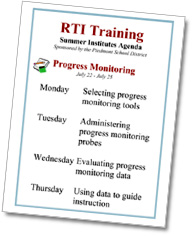How can school personnel effectively implement evidence-based practices or programs?
Page 6: Provide Training
 One of the best ways school personnel can promote fidelity of implementation is to provide effective professional development (PD) training. Research shows that teachers who receive high-quality training, which includes ongoing support, implement with greater fidelity than those who do not receive training. Moreover, those who receive extensive training typically implement with greater fidelity than those who receive minimal training.
One of the best ways school personnel can promote fidelity of implementation is to provide effective professional development (PD) training. Research shows that teachers who receive high-quality training, which includes ongoing support, implement with greater fidelity than those who do not receive training. Moreover, those who receive extensive training typically implement with greater fidelity than those who receive minimal training.
Many implementation efforts fail because someone underestimated the scope or importance of preparation.
 Through high-quality PD, school personnel learn the procedures and instructional activities necessary to implement a program or practice as intended. In addition, this training might serve to motivate teachers about the program and potential outcomes for their students as well as to build their confidence in their ability to implement the program effectively. When seeking high-quality PD, school personnel should look for training that:
Through high-quality PD, school personnel learn the procedures and instructional activities necessary to implement a program or practice as intended. In addition, this training might serve to motivate teachers about the program and potential outcomes for their students as well as to build their confidence in their ability to implement the program effectively. When seeking high-quality PD, school personnel should look for training that:
- Is provided by knowledgeable professionals
- Addresses skill development
Training Is Provided by Knowledgeable Professionals
Research demonstrates that direct training, led by a skilled instructor, is more effective than indirect training such as that provided by a video. The instructor or trainer should be a qualified professional with expertise in the topic at hand as well as a demonstrated ability to teach adults. How an implementation team chooses the PD provider depends on the type of training they are seeking. For example, a school in search of training on an instructional practice might wish to explore local experts (e.g., college faculty, local trainers) or inquire with the district, which may maintain a list of approved PD providers. However, if a school is seeking training on a specific product or program, the manufacturer, publisher, or developer may provide a trainer or supply a list of approved trainers. Regardless, it may be helpful to ask several questions when selecting a qualified trainer:
- What is the individual’s professional background?
- Does he or she use multiple teaching formats or models during training?
- Does he or she offer follow-up training support?
- Does the trainer provide a manual?
- Does the trainer address fidelity of implementation?
Mel Riddile and Cynthia Alexander discuss factors to consider when selecting professional development training.

Mel Riddile, EdD
National Association of
Secondary School Principals (NASSP)
2006 MetLife-NASSP High School Principal of the Year
(time: 1:49)

Cynthia Alexander
NIUSI-LeadScape Principal
Evans Elementary School
Memphis, TN
(time: 1:30)
Transcript: Mel Riddile, EdD
First of all, I want to make sure that our staff learn what it is they need to learn. We want to observe other people doing it. There should be opportunities for guided practice and for teachers to get feedback. In some cases, we visited other schools to watch them do it, and that was very important. We also built in a peer-observation component and a coaching component, so that the teachers would observe each other using the strategy and then give feedback to each other, and then the coach would observe them, go into their classroom, and work with them to make sure that they were actually implementing that strategy the way it was designed. But, more importantly, we wanted to know how much follow-up support we were going to get. And that’s a critical part, because, as I learned, nothing is perfect out-of-the-box, so to speak. And so we have to have some flexibility, and it has to be adapted to certain context. And to do that we want to know how much follow-up support we would get from the professional development organization, the program, whatever it was. The support from the vendor-provider organization that we are working with was a critical part of our choice of a path or a program. Do they have technical staff that can support us? The other thing is, can they come back and look at our needs and then provide follow-up support? Does the organization actually have a part of that organization that’s devoted to fidelity of implementation? Do they actually care if schools are implementing the programs as designed and what are they prepared to do to assist schools to do that.
Transcript: Cynthia Alexander
When considering finding the appropriate professional development for the staff, we go back to the data and the needs that are specifically for the school. The first thing you have to consider when selecting PD for a group of educators is what professional development will be the most beneficial for that group of teachers. So that’s what we do periodically, not just once a year. We have a professional-development plan, but it’s a living document, much like the school improvement plan, whereas we see needs evolve we also include those needs for PD in there. You have to be open to make changes as you go with professional development, because what you need at the beginning of the year you might find is not necessarily what you need. So it has to be an evolving process, and you have to make sure that they are relevant topics included in professional development for that time period in your school. There’s some things that will stay the same, but for the most part it’s an evolutionary process where you plan for that PD according to what the needs are. Now, as far as evaluation of the PD, at the end we do a needs assessment for the teachers to figure out was it useful PD, how will you use it, and then also offer them opportunities in team-leader meetings and faculty meetings to, kind of, present some of those high-points or lessons learned from the PD in the form of a lesson, a presentation, or just a quick blurb of what they got out of the PD and what they were able to translate back into their classroom. It’s always good to talk to your teachers to find out exactly what they need.
For Your Information
During the selection process, school personnel may want to find out whether the PD trainer:
- Provides culturally responsive content relevant to implementing the practice or program with students at their school.
- Engages in extensive planning and attends to detail when teaching skills that are especially complex or outside the school personnel’s experiences.
- Presents compelling evidence to persuade trainees that the program they are learning will positively affect their students’ learning.
Training Addresses Skill Development
As a result of effective PD training, teachers learn the skills needed to implement a product or practice effectively and with fidelity. Research shows that teachers want detailed, concrete instruction during training. This training may be provided in a variety of formats such as workshops, summer institutes, or in-service trainings. Regardless of the content or training format, effective training includes:
Presenting information – Typically delivered through a lecture or discussion, this includes all the facts and knowledge relevant to implementing the practice (e.g., benefits, steps or components, implementation instructions, research base, effectiveness).
Demonstrating the skill or concept – This may involve a live or taped model or simulation of an individual implementing the important aspects of the practice or program.
Providing opportunities to practice – Time should be allotted during the session for participants to practice the skills (sometimes referred to as role plays or behavior rehearsals). To be successful, training should provide opportunities for participants to receive corrective feedback on their performance in a supportive atmosphere.
corrective feedback
Constructive comments provided as soon as possible following the implementation of an activity in order to help an individual improve his or her performance.
Research Shows
Teachers who see the value in the practice or program, have the requisite skills to implement it, believe it will be effective in producing desired effects, and feel confident about implementing it are more likely to implement the program with a higher degree of fidelity.
(Barr, Tubman, Montgomery, & Soza-Vento, 2002; Ringwalt, Ennett, Johnson, Rohrbach, Simons-Rudolph, Vincus, & Thorne, 2003)
Evaluating PD Training
 To better meet the needs of school personnel, the coordinator or designated school team need to evaluate the training. They may do this to assess whether participants learned new content or skills, found the PD engaging, or applied the information or skills. The individuals in charge of coordinating PD activities may want to conduct several types of evaluations to gain insight into the effect of the training.
To better meet the needs of school personnel, the coordinator or designated school team need to evaluate the training. They may do this to assess whether participants learned new content or skills, found the PD engaging, or applied the information or skills. The individuals in charge of coordinating PD activities may want to conduct several types of evaluations to gain insight into the effect of the training.
| Evaluation Type | Purpose | Example |
| Pre-training assessment | Distributed before training:
|
Click here for an example. |
Pre-training Assessment
|
Peer Assisted Learning Strategies (PALS) Workshop
Pre-Training Assessment |
|||||
|
Very Little
|
Some
|
A Lot
|
|||
| 1. How much do you know about peer tutoring? |
1
|
2
|
3
|
4
|
5
|
| 2. How much do you know about PALS? |
1
|
2
|
3
|
4
|
5
|
| 3. Do you use PALS in your classroom? |
1
|
2
|
3
|
4
|
5
|
|
Not at All
|
Unsure
|
Definitely
|
|||
| 7. Do you believe students can learn effectively from each other? |
1
|
2
|
3
|
4
|
5
|
| 8. How comfortable are you letting students work together in pairs? |
1
|
2
|
3
|
4
|
5
|
| 9. How comfortable are you with following scripted lessons? |
1
|
2
|
3
|
4
|
5
|
| |
|||||
|
Very Little
|
Some
|
A Lot
|
|||
| 14. How much would you like to learn about implementing PALS? |
1
|
2
|
3
|
4
|
5
|
| 15. How much would you like to learn about the benefits of implementing PALS? |
1
|
2
|
3
|
4
|
5
|
(Close this panel)
| Post-training assessment | Distributed immediately after training:
|
Click here for an example. |
Post-training Assessment
|
Peer Assisted Learning Strategies (PALS) Workshop Post-Training Assessment
|
|||||
|
Very Little
|
Some
|
A Lot
|
|||
| 1. How much do you know about peer tutoring? |
1
|
2
|
3
|
4
|
5
|
| 2. How much do you know about PALS? |
1
|
2
|
3
|
4
|
5
|
| |
|||||
|
Not at All
|
Unsure
|
Definitely
|
|||
| 7. Do you believe students can learn effectively from each other? |
1
|
2
|
3
|
4
|
5
|
| 8. How comfortable are you letting students work together in pairs? |
1
|
2
|
3
|
4
|
5
|
| 9. How comfortable are you with following scripted lessons? |
1
|
2
|
3
|
4
|
5
|
| |
|||||
|
Very Little
|
Some
|
A Lot
|
|||
| 14. How much did you learn about implementing PALS? |
1
|
2
|
3
|
4
|
5
|
| 15. How much did you learn about the benefits of implementing PALS? |
1
|
2
|
3
|
4
|
5
|
(Close this panel)
| Overall training evaluation | Distributed immediately after training:
|
Click here for an example. |
Overall Training Evaluation Example
Workshop Title: ________________________________________________________________________
|
Strongly Agree | Agree | Neutral | Disagree | Strongly Disagree | ||
|
5 | 4 | 3 | 2 | 1 | ||
|
5 | 4 | 3 | 2 | 1 | ||
|
5 | 4 | 3 | 2 | 1 | ||
|
5 | 4 | 3 | 2 | 1 | ||
|
5 | 4 | 3 | 2 | 1 | ||
|
5 | 4 | 3 | 2 | 1 | ||
| The presenter(s)……………. | 5 | 4 | 3 | 2 | 1 | ||
|
5 | 4 | 3 | 2 | 1 | ||
|
5 | 4 | 3 | 2 | 1 | ||
|
5 | 4 | 3 | 2 | 1 | ||
|
5 | 4 | 3 | 2 | 1 | ||
|
5 | 4 | 3 | 2 | 1 | ||
|
5 | 4 | 3 | 2 | 1 | ||
|
5 | 4 | 3 | 2 | 1 | ||
|
5 | 4 | 3 | 2 | 1 | ||
|
5 | 4 | 3 | 2 | 1 | ||
|
Excellent | Above Average | Average | Below Average | Poor | ||
|
5 | 4 | 3 | 2 | 1 | ||
|
5 | 4 | 3 | 2 | 1 | ||
| 17. My level of belief in the importance of the content of this workshop in terms of benefiting the youth in my work: | |||||||
|
5 | 4 | 3 | 2 | 1 | ||
|
5 | 4 | 3 | 2 | 1 | ||
| 18. Please share any additional comments or feedback about this workshop: ________________________________________________________________________________________ ________________________________________________________________________________________ ________________________________________________________________________________________ ________________________________________________________________________________________
|
|||||||
(From the Out-of-School Time Resource Center [OSTRC],
http://www.sp2.upenn.edu/ostrc/resources/prodeveval/index.html)
(Close this panel)
| Follow-up assessment | Distributed after training (e.g., after one week, one month):
|
Click here for an example. |
Follow-up Assessment Example
| Fall Philly PNM Follow Up Survey | |||||||||||||||||||||||||||||
| Philadelphia Fall Peer Networking Meetings –Follow Up Survey | |||||||||||||||||||||||||||||
| Thank you for your continued support of the Philadelphia Peer Networking Meetings. Please take a few moments to complete this follow-up evaluation. Your feedback will help enhance our meetings and enrich the out-of-school time field. | |||||||||||||||||||||||||||||
| 1. How much did you learn from attending the Fall Peer Networking Meeting(s): | |||||||||||||||||||||||||||||
|
|||||||||||||||||||||||||||||
| Application | |||||||||||||||||||||||||||||
| 2. I applied the knowledge or skill(s) that I learned at the PNM in my work with youth. | |||||||||||||||||||||||||||||
| 3. I shared knowledge or skills from the PNM with colleagues. | |||||||||||||||||||||||||||||
| 4. I adapted the knowledge or skill from the PNM to other programs. | |||||||||||||||||||||||||||||
| 5. I had the support of my organization to implement the knowledge or skill learned at the PNM. | |||||||||||||||||||||||||||||
| 6. I was held accountable to apply the knowledge or skill from the PNM in my work with youth. | |||||||||||||||||||||||||||||
| Knowledge, Skills and Belief | |||||||||||||||||||||||||||||
| Now that some time has passed since attending a Fall Peer Networking meeting, please rate the following questions on a scale of 1 to 5: | |||||||||||||||||||||||||||||
| 7. Now that some time has passed, my level of knowledge and/or skills from attending the PNM is: |
|||||||||||||||||||||||||||||
|
|||||||||||||||||||||||||||||
| 8. Now that some time has passed, my level of belief in the importance of the topic(s), in terms of benefiting the youth in my work is: |
|||||||||||||||||||||||||||||
|
|||||||||||||||||||||||||||||
| 9. Thank you for taking the time to complete this survey. If you have any questions, comments or suggestions, please contact Lisa Colby, Senior Research Coordinator at the Out-of-School Time Resource Center at [email protected] or 215.898.2505.Please share any additional comments, feedback and/or suggestions about the Peer Networking Meetings. _______________________________________________________________________________ _______________________________________________________________________________ _______________________________________________________________________________ |
|||||||||||||||||||||||||||||
(From the Out-of-School Time Resource Center [OSTRC],
http://www.sp2.upenn.edu/ostrc/resources/prodeveval/index.html)
(Close this panel)
If the evaluations indicate that teachers did not learn the content or skills needed to implement a practice or program effectively, school personnel can use these data to decide on the most appropriate type of support (e.g., booster sessions, coaching). These data can also be used to determine whether a particular PD activity or trainer should be considered for future training opportunities.
 |
Click here for some additional tools to help identify and evaluate professional development. |
Tools for Identifying and Evaluating Professional Development
(Close this panel)

|

|

|
Provide Training
![]() Paige Elementary School
Paige Elementary School
 Because the district is strongly encouraging all schools to adopt RTI for reading, district personnel are providing training on the core components of the approach (e.g., high-quality reading instruction, progress monitoring). The school implementation team at Paige Elementary contacts the district about training opportunities and learns that the district will conduct a number of summer institutes, one of which focuses on progress monitoring. The implementation team is excited to learn this; they know that most teachers at Paige are not familiar with progress monitoring. They also feel that a number of teachers might be intimidated by the process of examining the data and of subsequently making instructional decisions based on the data. In addition to the summer training, the district will, upon request, provide booster sessions and support regarding progress monitoring.
Because the district is strongly encouraging all schools to adopt RTI for reading, district personnel are providing training on the core components of the approach (e.g., high-quality reading instruction, progress monitoring). The school implementation team at Paige Elementary contacts the district about training opportunities and learns that the district will conduct a number of summer institutes, one of which focuses on progress monitoring. The implementation team is excited to learn this; they know that most teachers at Paige are not familiar with progress monitoring. They also feel that a number of teachers might be intimidated by the process of examining the data and of subsequently making instructional decisions based on the data. In addition to the summer training, the district will, upon request, provide booster sessions and support regarding progress monitoring.
Although the implementation team believes that the district training will be invaluable, they believe that they should also find out more about any training or technical assistance provided by the company from which they are purchasing their progress monitoring materials. Viewing the company’s website, they see that the following supports are available:
- Video demonstrations
- Online training and conferencing
- Email support
- Phone support
Evaluating PD
At the end of the summer institute, district training personnel will conduct an overall training evaluation so that they can continuously improve their training. In addition, the district can use the evaluation data to provide follow-up support to target those skills that participants report they do not feel confident implementing.
| Summer Institute RTI: Progress Monitoring |
|||||||
| Directions: Rate each item below. Note that there are separate sections for “workshop” and “presenter.” | |||||||
| Strongly Agree |
Agree | Neutral | Disagree | Strongly Disagree |
|||
| Workshop | |||||||
|
5 | 4 | 3 | 2 | 1 | ||
|
5 | 4 | 3 | 2 | 1 | ||
|
5 | 4 | 3 | 2 | 1 | ||
|
5 | 4 | 3 | 2 | 1 | ||
|
5 | 4 | 3 | 2 | 1 | ||
|
5 | 4 | 3 | 2 | 1 | ||
| Presenter | |||||||
|
5 | 4 | 3 | 2 | 1 | ||
|
5 | 4 | 3 | 2 | 1 | ||
|
5 | 4 | 3 | 2 | 1 | ||
|
5 | 4 | 3 | 2 | 1 | ||
|
5 | 4 | 3 | 2 | 1 | ||
|
5 | 4 | 3 | 2 | 1 | ||
|
5 | 4 | 3 | 2 | 1 | ||
|
5 | 4 | 3 | 2 | 1 | ||
|
5 | 4 | 3 | 2 | 1 | ||
| Excellent | Above Average |
Average | Below Average | Poor | |||
|
5 | 4 | 3 | 2 | 1 | ||
|
5 | 4 | 3 | 2 | 1 | ||
|
5 | 4 | 3 | 2 | 1 | ||
|
5 | 4 | 3 | 2 | 1 | ||
|
5 | 4 | 3 | 2 | 1 | ||
|
5 | 4 | 3 | 2 | 1 | ||
| 18. Please share any additional comments or feedback about this workshop: ________________________________________________________________________________________ ________________________________________________________________________________________ ________________________________________________________________________________________ ________________________________________________________________________________________
|
|||||||
(Created by the Out-of-School Time Resource Center at the University of Pennsylvania. May not be reproduced without permission. The Trustees of the University of Pennsylvania. All rights reserved. Copyright 2007.)
(Close this panel)
Provide Training
![]() Grafton Middle School
Grafton Middle School
Investigating PD
The school implementation team decides that the teachers will benefit from training on how to use the reading program as it was intended to be used. Because the reading program is a commercially available product, the implementation team visits the publisher’s website to learn more about training opportunities. They locate a list of approved trainers and a description of the type of training available. The team also finds the answers to a number of questions:
Does the training include a manual?
Yes, the training will include a manual. This is in addition to the guidelines included in the materials the school purchased.
What type of training is provided?
The initial training on how to use the program will be provided by a company representative; he or she will provide a customized workshop based on Grafton’s needs. The teachers who serve as coaches will participate in an additional session with the trainer in order to learn the necessary coaching skills.
For answers to the remaining questions, the team speaks to the representative on the phone. She supplies the following information.
Does the trainer or vendor offer follow-up training support?
The trainer will offer ongoing support in the form of Webinar booster sessions and phone support.
Does the trainer use multiple teaching formats or models during training?
The trainer will address different levels of skill development during training.
Does the trainer address fidelity of implementation?
The trainer will address implementation fidelity but will not provide any further supports (e.g., observation forms, teacher surveys).
Evaluating PD
The implementation team decides to evaluate the PD they receive from the trainer. Because the teachers have different levels of knowledge about reading instruction, they choose to do a pre- and post-training assessment. Some of the teachers were part of the initial attempt to implement the reading program several years ago, whereas others have no experience with the reading program at all.
|
Grafton Middle School
Reading Program Pre-Training Survey |
|||||
|
Very Little
|
Some
|
A Lot
|
|||
| 1. How much do you know about this reading program? |
1
|
2
|
3
|
4
|
5
|
| 2. Have you ever used this reading program in your classroom? |
1
|
2
|
3
|
4
|
5
|
| 3. Do you currently use this reading program in your classroom? |
1
|
2
|
3
|
4
|
5
|
| 4. If you currently implement this reading program, how often do you do so? |
1
|
2
|
3
|
4
|
5
|
| |
|||||
|
Not at All
|
Unsure
|
Definitely
|
|||
| 7. Do you believe this reading program can help improve the reading performance of your students? |
1
|
2
|
3
|
4
|
5
|
| 8. How comfortable are you implementing this reading program? |
1
|
2
|
3
|
4
|
5
|
| 9. How comfortable are you with following scripted lessons? |
1
|
2
|
3
|
4
|
5
|
|
Very Little
|
Some
|
A lot
|
|||
| 14. How much would you like to learn about implementing this reading program? |
1
|
2
|
3
|
4
|
5
|
| 15. How much would you like to learn about the benefits of implementing this reading program. |
1
|
2
|
3
|
4
|
5
|
| |
|||||
|
Grafton Middle School Reading Program Post-Training Survey
|
|||||
|
Very Little
|
Some
|
A Lot
|
|||
| 1. How much do you know about this reading program? |
1
|
2
|
3
|
4
|
5
|
|
Not at All
|
Unsure
|
Definitely
|
|||
| 7. Do you believe this reading program can help improve the reading performance of your students? |
1
|
2
|
3
|
4
|
5
|
| 8. How comfortable are you implementing this reading program? |
1
|
2
|
3
|
4
|
5
|
| 9. How comfortable are you with following scripted lessons? |
1
|
2
|
3
|
4
|
5
|
|
Very Little
|
Some
|
A Lot
|
|||
| 14. How much did you learn about implementing this reading program? |
1
|
2
|
3
|
4
|
5
|
| 15. How much did you learn about the benefits of implementing this reading program. |
1
|
2
|
3
|
4
|
5
|
(Close this panel)
Provide Training
![]() DuBois High School
DuBois High School
As the school improvement team soon learns, the PBIS Technical Assistance Center requires a 3–5 year training commitment from participating schools. A team (which includes administrators and general and special education teachers) of ten school representatives will receive training and in turn will train the remainder of the staff. The training takes two or three days and is provided by skilled trainers. As they learn more about what is required to implement PBIS, the members of the school improvement team create the table below to help organize the new information.
| Contacts | ||||||||||||||||||
|
||||||||||||||||||
| Who | When/ Length | Where | By Whom | |||||||||||||||
| Initial Training |
|
|
|
|
||||||||||||||
| Follow-up Training |
||||||||||||||||||
| Training of New Staff |
||||||||||||||||||
(Close this panel)






